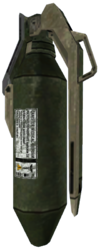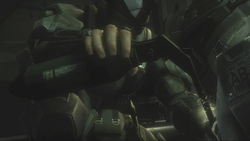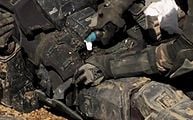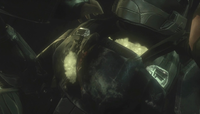Biofoam: Difference between revisions
From Halopedia, the Halo wiki
No edit summary |
(→Trivia: Link rotted to redirect to AI generated content. Exchanged with legitimate link from DARPA.) |
||
| (43 intermediate revisions by 18 users not shown) | |||
| Line 1: | Line 1: | ||
{{ | {{Status|Canon}} | ||
[[File: | [[File:BiofoamCanister.png|100px|thumb|A biofoam canister.]] | ||
'''Biofoam''' is a self-sealing, space-filling coagulant and an | '''Biofoam''' (short for '''biomedical foam''')<ref>'''Halo: New Blood''', ''pages 66-67'' (Google Play edition)</ref><ref name="universe">[https://www.halowaypoint.com/en-us/universe/tech/biofoam '''Halo Waypoint''': ''Biofoam'']</ref> is a self-sealing, space-filling coagulant and an antimicrobial, tissue-regenerative foam polymer used by the [[United Nations Space Command]] as a form of medical first aid. This foam keeps damaged organs in place and helps stop bleeding and hemorrhaging. The medicinal compound is morphophetamine in a polyethyltriphosphate liquid medium dispensed with nitrous oxide. When applied, the polyethyltriphosphate and nitrous oxide mix to create a foaming effect that can encapsulate, disinfect, and numb wounds.{{Ref/Novel|Id=TRP5|TRP|Chapter=5}} Within the [[Unified Earth Government]], biofoam is an [[Wikipedia:Over-the-counter|OTC-legal product]] and can be purchased legally "over-the-counter."{{Ref/Reuse|universe}} | ||
==Overview== | |||
===Contents=== | |||
Prior to application, biofoam consists of two substances: nitrous oxide and morphophetamine-infused liquid polyethyltriphosphate,{{Ref/Reuse|TRP5}} with the latter incorporating [[MediGel]], a product of [[Optican]].{{Ref/Book|Id=Enc22P29|Enc22|Page=29}} | |||
===Usage and effects=== | |||
[[File:Biofoam 02.png|250px|thumb|Biofoam being applied.]] | |||
Biofoam is generally contained within a cylindrical canister or bottle with a deployable nozzle used to apply the mixture directly to the affected area of a patient,<ref name="Kikowani">''[[Halo 3: ODST]] level, Kikowani Station''</ref> although it can also be rubbed into a wound rather than injected.{{Ref/Reuse|h2sg}} When applied and exposed to air, the nitrous oxide and liquid polyethyltriphosphate mix, they produce a foaming reaction.{{Ref/Reuse|TRP5}} The foam strongly adheres to tissues and simultaneously releases encapsulated medical compounds that advances clotting, disinfects the wound, and eventually numbs pain. After a short duration of time, the foam applied will set and become a semi-rigid, porous mass internally, which forms a hardened skin on regions of the body exposed to air.{{Ref/Reuse|universe}} The standard dosage is 10 centiliters (10cL) or 3.38 fl. oz.<ref>'''Halo 3: ODST''' biofoam texture graphic file</ref> | |||
The [[ | Despite biofoam's numbing properties, for the first few seconds after its application to an open wound, it is known to be very painful,{{Ref/Reuse|TRP5}} described as feeling like "burning ants crawling around the wound" and "thousands of tiny knives" stabbing the recipient.{{Ref/Reuse|h2sg}}<ref>'''Halo: The Flood''', ''page ???''</ref> Biofoam does not seem to have this kind of painful reaction when applied to an unwounded area, as during the [[Battle of Mombasa]], [[Jonathan Doherty]] was seen spraying a small amount onto his uninjured fingers and does not react in pain. The effects of biofoam are temporary, and after a few hours, it simply breaks down. Therefore, it is normally a form of first aid, used only as a temporary sealant until proper medical attention can be sought.{{Ref/Reuse|TRP5}} In extremely rare cases, allergic reactions to biofoam have been documented. [[Wikipedia:Edema|Edema]] is a rare side effect of biofoam, caused by excess fluid trapped in the body's tissues.{{Ref/Reuse|universe}} | ||
===Applications=== | |||
Biofoam is often used as a medical option when there are no [[Hospital Corpsman|medical personnel]] available. Bottles of biofoam can be found in [[health pack]]s.<ref>'''Halo: The Fall of Reach''', ''page 91''</ref><ref>'''Halo: First Strike''', ''page 123'' (''"William retrieved a can of biofoam from the rover and inserted the tip into the tiny injection port in his armor—pushed it through the skin between his fourth and fifth ribs. He filled his abdominal cavity with the space-filling coagulant/antibacterial/tissue-regenerative polymer."'')</ref> [[UNSC]] medics will use it as a sealing agent during treatment in the field.{{Ref/Reuse|TRP5}} The [[MJOLNIR Powered Assault Armor/Mark VI|MJOLNIR Mark VI]],<ref name="h2sg">'''[[Halo 2: The Official Strategy Guide]]'''</ref> [[MJOLNIR Powered Assault Armor (GEN2)|MJOLNIR GEN2]],{{Ref/Game|Id=H4|Game=Halo 4}} and [[MJOLNIR Powered Assault Armor (GEN3)|MJOLNIR GEN3]]{{Ref/Novel|Id=sorchapt5|Novel=Halo: Shadows of Reach|Chapter=5}} armors contain automatic biofoam injectors, which negate the need for their [[SPARTAN programs|Spartan]] wearers to use health packs. | |||
==Trivia== | ==Trivia== | ||
*Despite the | *Despite the application process being rather painful, when biofoam is applied to [[Kojo Agu|Romeo's]] wound in ''[[Halo 3: ODST]]'', he sighs with relief, rather than showing signs of discomfort. This might result from his rigorous [[ODST]] training, or be due to his relief that he can breathe properly again. | ||
*In ''Halo 3: ODST'' biofoam is applied by inserting part of the canister into the wound. In ''Halo: Landfall'' however, biofoam is applied like shaving cream | *In ''Halo 3: ODST'' biofoam is applied by inserting part of the canister into the wound. In ''[[Halo: Landfall]]'' however, biofoam is applied like shaving cream, which could mean that biofoam works internally and externally. | ||
*The closest equivalent in the modern world to biofoam is Quikclot combat gauze, which utilizes kaolin nanoparticles impregnated into gauze. It is designed to stop moderate to severe bleeding and stabilize a combat casualty. However, it is not a foam, and as gauze, it must be packed into the wound. An [https://www.darpa.mil/program/wound-stasis-system experimental foam] developed in late [[2012]] by [[Wikipedia:DARPA|DARPA]] also bears many similarities to biofoam, as it is capable of packing combat wounds and halting internal bleeding. | |||
==Gallery== | ==Gallery== | ||
<gallery | <gallery> | ||
File:UNSC-Biofoam-logo1.jpg|Biofoam packaging container label. | |||
File:BioFoam.jpg|Biofoam being used in ''[[Halo: Landfall]]''. | File:BioFoam.jpg|Biofoam being used in ''[[Halo: Landfall]]''. | ||
File:Biofoam_03.png|Biofoam exuding out of | File:Biofoam_03.png|Biofoam exuding out of Romeo's damaged chest plate. | ||
File:Sullivan_biofoam.jpg|The [[John-117|Master Chief]] applies biofoam to [[Michael Sullivan]]'s wound in ''[[Halo 4: Forward Unto Dawn]]''. | File:Sullivan_biofoam.jpg|The [[John-117|Master Chief]] applies biofoam to [[Michael Sullivan]]'s wound in ''[[Halo 4: Forward Unto Dawn]]''. | ||
File:HINF Mr Bones Chest Icon.png|The "Mr. Bones" chest attachment for the [[MJOLNIR Powered Assault Armor/Mark VII|MJOLNIR Mark VII]] armor core in ''[[Halo Infinite]]'', featuring a biofoam canister. | |||
</gallery> | </gallery> | ||
| Line 24: | Line 34: | ||
*''[[Halo: The Flood]]'' | *''[[Halo: The Flood]]'' | ||
*''[[Halo: First Strike]]'' | *''[[Halo: First Strike]]'' | ||
*''[[Halo: Landfall]]'' | |||
*''[[Halo: The Cole Protocol]]'' | |||
*''[[Halo 3: ODST]]'' | *''[[Halo 3: ODST]]'' | ||
*''[[Halo: Evolutions - Essential Tales of the Halo Universe]]'' | |||
**''[[Pariah]]'' | |||
**''[[Dirt]]'' | |||
**''[[Blunt Instruments]]'' | |||
*''[[Halo 4: Forward Unto Dawn]]'' | *''[[Halo 4: Forward Unto Dawn]]'' | ||
*''[[Halo: New Blood]]'' | |||
*''[[Halo: Last Light]]'' | |||
*''[[Halo: The Fall of Reach - The Animated Series]]'' | |||
*''[[Halo: Fractures]]'' | |||
**''[[Into the Fire]]'' {{Mo}} | |||
*''[[Halo: Envoy]]'' | |||
*''[[Halo: Oblivion]]'' | |||
*''[[Halo: Shadows of Reach]]'' | |||
*''[[Halo: Divine Wind]]'' | |||
*''[[Halo Infinite]]'' | |||
*''[[Halo: The Rubicon Protocol]]'' | |||
==Sources== | ==Sources== | ||
{{Ref/Sources}} | |||
[[Category:Medicine]] | [[Category:Medicine]] | ||
Latest revision as of 05:45, August 4, 2024
Biofoam (short for biomedical foam)[1][2] is a self-sealing, space-filling coagulant and an antimicrobial, tissue-regenerative foam polymer used by the United Nations Space Command as a form of medical first aid. This foam keeps damaged organs in place and helps stop bleeding and hemorrhaging. The medicinal compound is morphophetamine in a polyethyltriphosphate liquid medium dispensed with nitrous oxide. When applied, the polyethyltriphosphate and nitrous oxide mix to create a foaming effect that can encapsulate, disinfect, and numb wounds.[3] Within the Unified Earth Government, biofoam is an OTC-legal product and can be purchased legally "over-the-counter."[2]
Overview[edit]
Contents[edit]
Prior to application, biofoam consists of two substances: nitrous oxide and morphophetamine-infused liquid polyethyltriphosphate,[3] with the latter incorporating MediGel, a product of Optican.[4]
Usage and effects[edit]
Biofoam is generally contained within a cylindrical canister or bottle with a deployable nozzle used to apply the mixture directly to the affected area of a patient,[5] although it can also be rubbed into a wound rather than injected.[6] When applied and exposed to air, the nitrous oxide and liquid polyethyltriphosphate mix, they produce a foaming reaction.[3] The foam strongly adheres to tissues and simultaneously releases encapsulated medical compounds that advances clotting, disinfects the wound, and eventually numbs pain. After a short duration of time, the foam applied will set and become a semi-rigid, porous mass internally, which forms a hardened skin on regions of the body exposed to air.[2] The standard dosage is 10 centiliters (10cL) or 3.38 fl. oz.[7]
Despite biofoam's numbing properties, for the first few seconds after its application to an open wound, it is known to be very painful,[3] described as feeling like "burning ants crawling around the wound" and "thousands of tiny knives" stabbing the recipient.[6][8] Biofoam does not seem to have this kind of painful reaction when applied to an unwounded area, as during the Battle of Mombasa, Jonathan Doherty was seen spraying a small amount onto his uninjured fingers and does not react in pain. The effects of biofoam are temporary, and after a few hours, it simply breaks down. Therefore, it is normally a form of first aid, used only as a temporary sealant until proper medical attention can be sought.[3] In extremely rare cases, allergic reactions to biofoam have been documented. Edema is a rare side effect of biofoam, caused by excess fluid trapped in the body's tissues.[2]
Applications[edit]
Biofoam is often used as a medical option when there are no medical personnel available. Bottles of biofoam can be found in health packs.[9][10] UNSC medics will use it as a sealing agent during treatment in the field.[3] The MJOLNIR Mark VI,[6] MJOLNIR GEN2,[11] and MJOLNIR GEN3[12] armors contain automatic biofoam injectors, which negate the need for their Spartan wearers to use health packs.
Trivia[edit]
- Despite the application process being rather painful, when biofoam is applied to Romeo's wound in Halo 3: ODST, he sighs with relief, rather than showing signs of discomfort. This might result from his rigorous ODST training, or be due to his relief that he can breathe properly again.
- In Halo 3: ODST biofoam is applied by inserting part of the canister into the wound. In Halo: Landfall however, biofoam is applied like shaving cream, which could mean that biofoam works internally and externally.
- The closest equivalent in the modern world to biofoam is Quikclot combat gauze, which utilizes kaolin nanoparticles impregnated into gauze. It is designed to stop moderate to severe bleeding and stabilize a combat casualty. However, it is not a foam, and as gauze, it must be packed into the wound. An experimental foam developed in late 2012 by DARPA also bears many similarities to biofoam, as it is capable of packing combat wounds and halting internal bleeding.
Gallery[edit]
Biofoam being used in Halo: Landfall.
The Master Chief applies biofoam to Michael Sullivan's wound in Halo 4: Forward Unto Dawn.
The "Mr. Bones" chest attachment for the MJOLNIR Mark VII armor core in Halo Infinite, featuring a biofoam canister.
List of appearances[edit]
- Halo: The Fall of Reach (First appearance)
- Halo: The Flood
- Halo: First Strike
- Halo: Landfall
- Halo: The Cole Protocol
- Halo 3: ODST
- Halo: Evolutions - Essential Tales of the Halo Universe
- Halo 4: Forward Unto Dawn
- Halo: New Blood
- Halo: Last Light
- Halo: The Fall of Reach - The Animated Series
- Halo: Fractures
- Into the Fire (Mentioned only)
- Halo: Envoy
- Halo: Oblivion
- Halo: Shadows of Reach
- Halo: Divine Wind
- Halo Infinite
- Halo: The Rubicon Protocol
Sources[edit]
- ^ Halo: New Blood, pages 66-67 (Google Play edition)
- ^ a b c d Halo Waypoint: Biofoam
- ^ a b c d e f Halo: The Rubicon Protocol, chapter 5
- ^ Halo Encyclopedia (2022 edition), page 29
- ^ Halo 3: ODST level, Kikowani Station
- ^ a b c Halo 2: The Official Strategy Guide
- ^ Halo 3: ODST biofoam texture graphic file
- ^ Halo: The Flood, page ???
- ^ Halo: The Fall of Reach, page 91
- ^ Halo: First Strike, page 123 ("William retrieved a can of biofoam from the rover and inserted the tip into the tiny injection port in his armor—pushed it through the skin between his fourth and fifth ribs. He filled his abdominal cavity with the space-filling coagulant/antibacterial/tissue-regenerative polymer.")
- ^ Halo 4
- ^ Halo: Shadows of Reach, chapter 5





